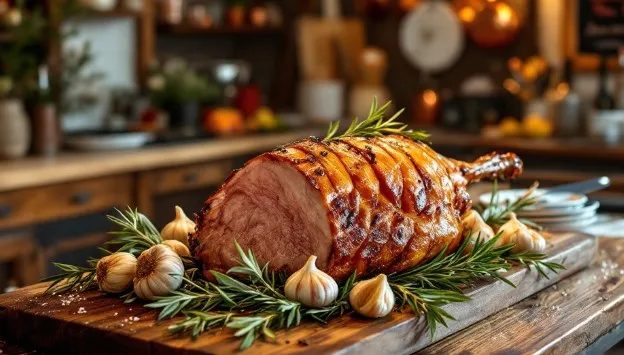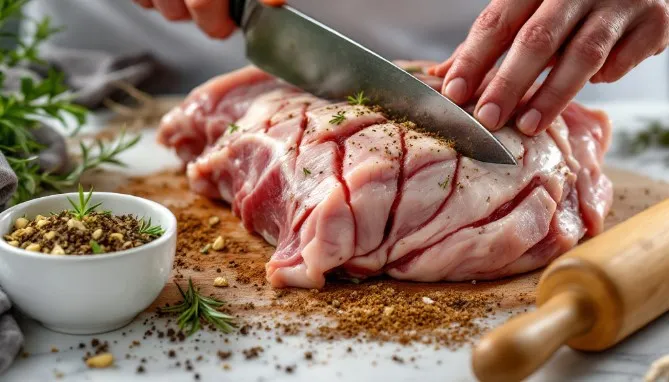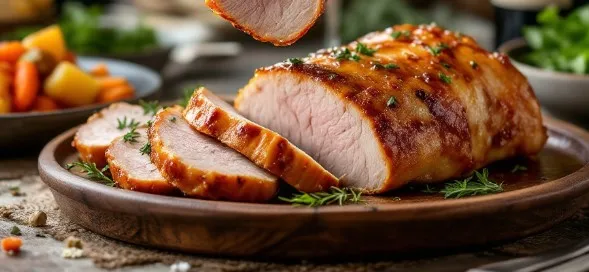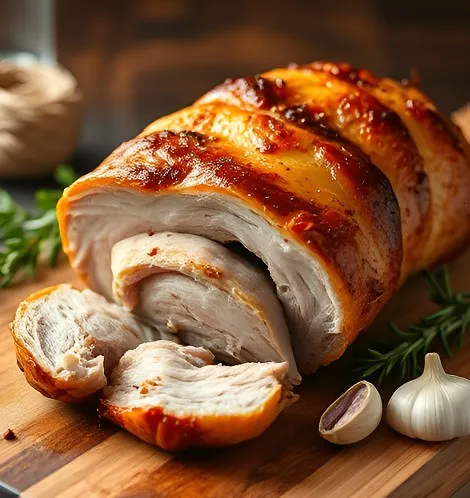Alright, let’s get cooking! You’re about to embark on a flavorful journey into the world of porketta, a dish that’s way more awesome than its kinda funny name might suggest! Think juicy, flavorful roast pork with crispy skin—seriously, what’s not to love? In this guide, we’ll break down everything you need to know, from what exactly porketta is, to making your own at home like a total pro. We’ll also compare it to its close cousin, porchetta, and cover all the best tips and tricks. It’s going to be a delicious ride, so buckle up!
Table of Contents
Unveiling the Roasted Delight

Defining the Porketta: A Culinary Introduction
Okay, so first things first: what exactly is porketta? Simply put, it’s a super delicious Italian-style roasted pork shoulder. You know, the kind of thing that makes your mouth water just thinking about it. Unlike your regular old roast pork, this Porketta is usually seasoned heavily with herbs and spices, which is what gives it that amazing, unforgettable flavor. It’s then slow-cooked to perfection, resulting in tender, juicy meat and a wonderfully crispy, crunchy skin. It’s basically the superstar of any meal, if you
Tracing Its Roots
While the exact history of porketta can be a bit murky—I mean, who’s really keeping track of all the delicious pork recipes through the ages, right?—we know it comes from Italy, a place known for its incredible food. Now, some folks think it might have started out as a peasant Porketta, a way to make use of cheaper cuts of pork, while others think it was a celebration dish for special occasions. Whatever its origin, it’s clear porketta has traveled across the oceans and into the hearts (and stomachs) of people everywhere. And, honestly, thank goodness for that!
What Makes It Unique?
What makes porketta stand out from the crowd? Well, a couple of things, actually! It’s all about the combo of a good cut of pork shoulder (we’ll get into details later), the right herbs (think: rosemary, garlic, fennel seeds), and the way it’s cooked. The goal is always a super-flavorful piece of meat that’s crazy tender and has that unforgettable crackly skin. It’s like, the perfect bite, every single time. You know? Porketta is also usually rolled and tied before roasting, which helps it cook evenly and keep its shape. And honestly, it’s this careful prep and cooking that really makes all the difference.
Exploring Similarities and Differences
A Head-to-Head Comparison
Now, you might be thinking, “Wait a minute, isn’t porketta just another name for porchetta?” Well, that’s a fair question, and you’re not alone in wondering about this! Honestly, the names are so similar, it’s easy to get them mixed up. While both dishes are about roasting a flavorful cut of pork, there are some key differences. Porchetta typically uses a whole pig (yes, the entire thing!) and is roasted whole, while porketta generally uses just the pork shoulder, which is a smaller cut. So, though they share similar flavor profiles and both feature that incredible crispy skin, porchetta is, generally speaking, the more grand and ambitious production. It’s like comparing a BBQ chicken flatbread to a whole pizza, both are awesome, but one is a bit more complex.
Variations Across Regions
Moreover, like many dishes, variations of porketta exist across different regions in Italy and even in other parts of the world. In some places, for instance, you might find porketta made with slightly different herb mixtures or with a different cooking method. This is what makes food so interesting! The basics stay the same, but different cooks add their own twists and turns. Therefore, you can see how different regions of Italy might have subtle differences between them, and once this dish has made it overseas, things get even more interesting!
Core Distinctions in Preparation Porketta
Furthermore, another major difference comes down to the way the two dishes are prepped. Porchetta, being a whole pig, requires some serious butchering skills and equipment, whereas porketta, using just the shoulder, is a lot easier to manage for a home cook. Consequently, the prep time and effort involved are quite different. Plus, the cooking time will vary a lot as a result of the size difference. So, while both dishes are delicious, porketta is the more approachable option for someone making a fantastic roasted pork at home.
Why the Name Difference?
Finally, if you are still scratching your head about why we have two different names for such similar dishes, it could be down to regional dialect differences, as the two dishes may have been made in different regions of Italy. Or, it could be that the specific use of a pig shoulder instead of a whole hog is just one of those things that gets a new name. It’s like a BBQ chicken flatbread becoming a “flatbread pizza” because that’s just what the restaurant down the street calls it! It’s a mystery to some, but we’re glad they are both here.
Key Ingredients for Authentic Flavor
The Crucial Role of Pork Shoulder
So, let’s talk about what makes porketta so darn tasty – the ingredients, of course! First off, the star of the show is definitely the pork shoulder. You want to go for a good cut with a fair amount of fat, because that fat is what’s going to keep the meat juicy and flavorful while it cooks. Also, you want to make sure there is skin on there too because that’s what makes that crispy crackle, which, let’s face it, is a pretty important part of the whole porketta experience. You’ll often see it sold as a “Boston Butt” which can be a bit confusing, but that’s the one you want.
Essential Herbs and Spices
Next up, let’s talk herbs and spices because these are the powerhouses that really set porketta apart. Rosemary is a must-have, giving that classic earthy, piney flavor. Fennel seeds are also essential, and add a unique anise-like note that is just totally awesome. In addition to these key players, we need the spices, most importantly, salt and black pepper. These are what make any good cut of meat great. Honestly, if you’re doing BBQ chicken flatbread, you’d want a great mix of spices too!
The Significance of Garlic and Other Aromatics
Furthermore, let’s not forget the garlic! Seriously, garlic makes almost anything better, right? Lots of fresh garlic cloves are essential for creating that fantastic flavor we all crave. Additionally, some recipes might include other aromatics like lemon zest or a touch of red pepper flakes to give it a bit of a kick. It’s really all about that balance of flavors, you know? A little bit of this, a little bit of that. It’s all part of the magic.
Salt and Other Seasoning Considerations
Finally, the right amount of salt is another essential element in making a good porketta. It not only adds flavor but also helps to draw moisture out of the skin, making it nice and crispy. You’ll also want to use coarse ground salt as well. Many people believe that it helps with the crisping process of the skin. And, like I said, black pepper is super important too. It works with the other spices to make sure that the porketta gets that deep rich flavor. So, when you’re gathering your ingredients, make sure to grab the best and freshest you can find, and get ready for a seriously tasty result.
: Preparing the Porketta : A Step-by-Step Guide

Choosing the Right Cut: A Guide
Alright, so you’re ready to roll, and before we get started, let’s talk about finding the right pork shoulder. When you’re at the store, look for a piece that has a good amount of fat marbled throughout the meat. This fat is your friend and will keep the porketta nice and juicy. Also, you’re gonna want to make sure the skin is still attached. A good-sized shoulder should weigh anywhere from 3-5 pounds or so. If you don’t see exactly what you’re looking for, ask the butcher! They’ll be happy to help you find the perfect cut for your porketta masterpiece.
Preparing the Herb and Spice Mixture
Next up, it’s time to whip up the herb and spice mixture, and trust me, this is where the magic really starts to happen. Get a small bowl and toss in your chopped fresh rosemary, fennel seeds, lots of minced garlic, salt, black pepper, and any other spices you want to use. Mix it all up, and if you want to, add a little olive oil. This not only helps it stick to the meat, but it also helps distribute the flavor. Honestly, the smells alone are enough to make you excited to start cooking. It’s like making the perfect seasoning for, I don’t know, a BBQ chicken flatbread, but for pork!
The Art of Scoring and Rubbing the Pork
Okay, now comes the fun part. Take your pork shoulder and lay it flat on a clean cutting board. Using a sharp knife, score the skin in a crosshatch pattern. This helps the fat render and the skin crisp up beautifully. Be careful not to cut into the meat itself, though. After you score the skin, take your herb and spice mixture and start rubbing it all over the meat, getting into all the nooks and crannies. Make sure you really get in there, massaging it into the meat. This is what gets all that flavor locked in. The best way to do it is to get your hands dirty.
Rolling and Tying the Roast
Then, carefully roll the pork shoulder into a tight log shape, kind of like you’re making a super big, meaty jelly roll. Use kitchen twine to tie it securely in several places. The twine helps hold the shape of the porketta while it cooks, making it look nice and presentable when it’s done. If you’ve ever seen a porketta roast in a fancy deli, you know what I mean.
Ensuring Even Cooking: Temperature and Timing Tips
Finally, before you start cooking, it’s important to know how to ensure your porketta cooks evenly. For the best results, you will want to use a meat thermometer. Stick it in the thickest part of the roast and you’ll be able to track it as it cooks. You’ll want an internal temperature of around 145°F when it is done, which means that, depending on your cooking method, it might take a few hours. So be patient, and let the magic happen. We have some great resources here on recipesbaker.com on cooking temperatures. For more great tips, check out our How to use a meat thermometer guide.
Cooking Methods: Roasting Your Perfect Porketta
Traditional Oven Roasting: Mastering the Classic Method
The most common way to cook a porketta is by using a traditional oven. It’s actually really easy, and you’ll get that perfect crispy skin. Start by preheating your oven to a high temperature, like 450°F, and roast the pork for 30 mins. Then, lower the temp to 325°F and continue roasting until the internal temp reaches 145°F. This high initial heat gets the skin nice and crisp, and then the lower heat cooks the meat through. Keep an eye on it, and if the skin starts to get too brown, you can cover it loosely with foil.
Outdoor Grilling: Adding Smoky Flavors
If you’re looking for an alternative cooking method, outdoor grilling is great too. It’s a fun, easy way to add a smoky flavor to your porketta, especially if you use a charcoal grill. Set up your grill for indirect heat, place the porketta on the grates, and cook it with the lid closed. Try using wood chips to get that extra smokiness, and remember to use a meat thermometer to check that it’s cooked all the way through.
Slow Cooking and Braising: Alternative Approaches
Another way to cook porketta is by slow cooking it in a Dutch oven. If you are using this method, sear the porketta first on all sides and then cover it with a liquid like wine or broth before putting it in the oven. This will give you an incredibly tender and juicy result. This method allows you to cook at a much lower temperature, but will take a longer time than regular oven baking.
Achieving the Perfect Result: Tips and Tricks
The Importance of Resting After Cooking
Okay, so your porketta is cooked to perfection, and you’re super eager to slice into it, right? But, trust me, resting is crucial. After you take it out of the oven, let it rest for at least 15-20 minutes before carving. This rest time gives the juices a chance to redistribute throughout the meat, making each bite extra juicy. Honestly, it’s like the secret ingredient nobody talks about! Resist that urge, and your porketta will thank you for it.
Achieving Crispy Skin and Juicy Meat
Getting that perfect combination of crispy skin and juicy meat is what porketta is all about. To get the skin crispy, make sure you’re using high heat at the beginning of the roasting process. Scoring the skin properly is also a game-changer, as this helps the fat render and the skin to crisp up nicely. Remember, cooking to the correct internal temperature is what makes the meat juicy. So use a meat thermometer. Getting this right is the whole point. You want both: a crispy skin and a moist, tender interior.
Common Pitfalls to Avoid
There are a couple of common things that folks get wrong when making porketta. First, make sure to not overcook the meat, as it’ll dry out. Also, if the skin doesn’t crisp up, that’s usually because the initial heat wasn’t high enough, or the skin was not scored properly. Another common mistake is not using enough salt which, as I’ve mentioned, is a flavor essential and helps with the skin. So, when in doubt, just remember those core principles: high initial heat for the skin, proper scoring, and don’t skimp on the salt.
Tips for Perfect Internal Temperatures
Finally, let’s talk about internal temps. The best way to know when your porketta is done is by using a meat thermometer. As I’ve already said, you want to hit an internal temperature of around 145°F. Stick the thermometer into the thickest part of the meat. Once it reaches 145°F, pull it out of the oven and let it rest. You’re going to get that perfect, juicy, and cooked-all-the-way-through porketta every time.
Part 7: Serving and Enjoying Your Porketta

Ideal Serving Suggestions and Sides
Now that your porketta is cooked and rested, it’s time to serve it up! Porketta is amazing on its own, but if you want to make it a full meal, you’ll want to pair it with some great side dishes. Roasted vegetables like potatoes, carrots, or Brussels sprouts work great, and a simple salad or some crusty bread are other great options. If you wanna get fancy, a creamy polenta is also a winner.
The Best Ways to Slice and Serve
To slice your porketta, use a sharp carving knife and slice it into thick, generous slices. Don’t be shy! Remember to cut across the grain for the most tender slices. Serve it up immediately with your favorite sides. I mean, if you made a BBQ chicken flatbread, you wouldn’t hide that great creation, would you? The same is true for a great porketta, proudly display your amazing work!
Creative Ways to Use Leftovers
Lastly, if you somehow manage to have leftovers (though, let’s face it, that’s pretty unlikely), there are so many awesome ways to use them. Use it for amazing sandwiches the next day, or shred the pork and add it to pasta or tacos. You can even add some shredded porketta to a salad, making it super yummy. Leftovers can become brand-new meals and you’ll have a delicious, quick and easy lunch to enjoy.

